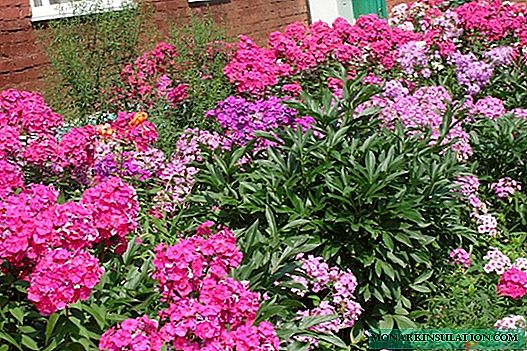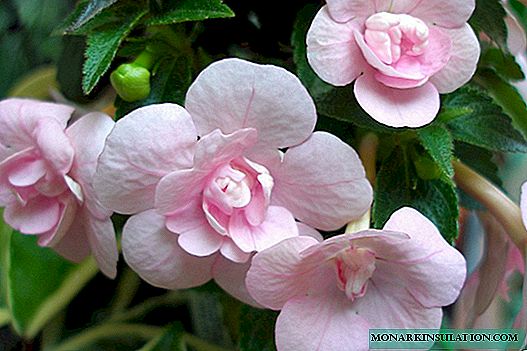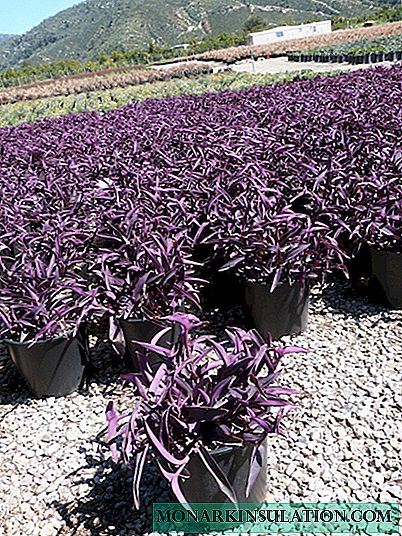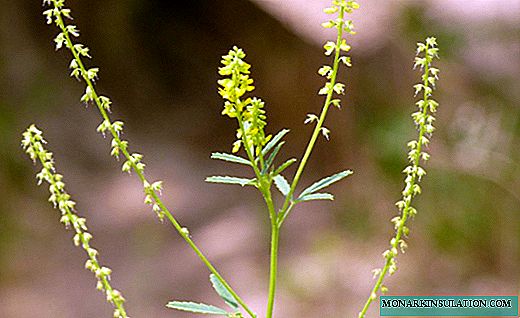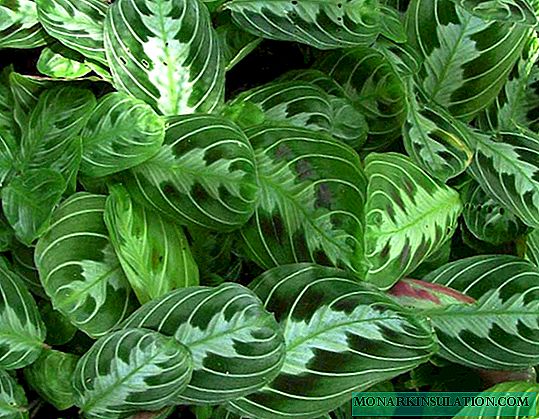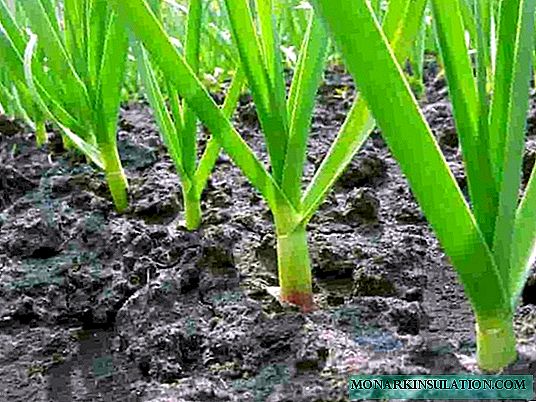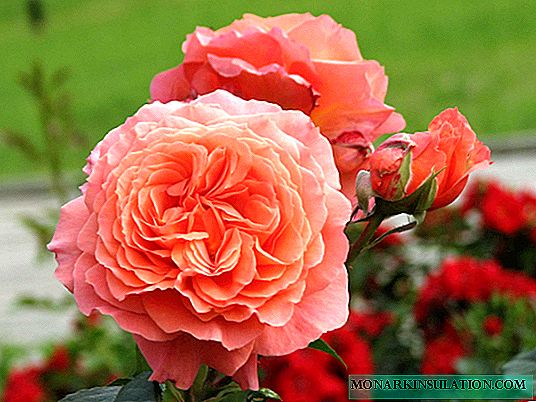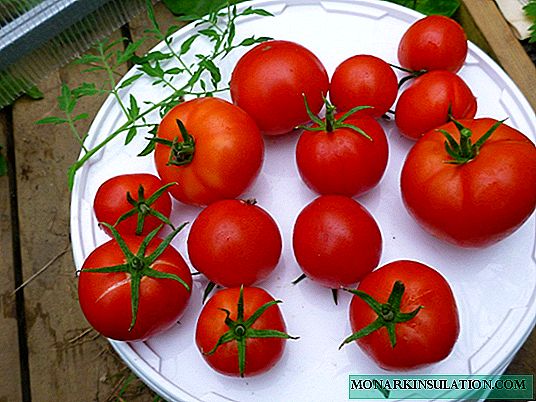
There are summer residents who have no time to seriously engage in the garden, but want to grow the most necessary vegetables. For them there are varieties that require little attention. Among tomatoes, one of such few varieties is Yablonka of Russia, fruiting in the early stages and quite plentifully. The fruits can be used fresh and are ideal for canning.
Description of tomato varieties Yablonka Russia
Tomato Yablonka of Russia is a representative of varieties that do not produce record yields or very large fruits of unsurpassed quality. This is just a very reliable variety, planting which, you can get good tomatoes without any problems and guaranteed, moreover, in the early stages and very elegant in appearance.
Origin, growing region
The tomato variety Yablonka of Russia was bred by the breeders of the company Gardens of Russia at the end of the last millennium. It is intended mainly for open ground, but if necessary, can be grown in greenhouses. There is a popular belief that this is not an independent variety, but a derivative of a rather old tomato variety of Tamina, known for more than thirty years. However, experts refute this assumption.
The variety was registered in the State Register of the Russian Federation in 2000 and is recognized as suitable for cultivation in absolutely all climatic regions. Of course, this does not mean that it can be cultivated, for example, in unprotected soil in the Far North: this is impossible by definition. But where, in principle, tomatoes grow, the Yablonka of Russia feels good.
According to an official document, the variety is recommended to be grown on small farms: in summer cottages and personal subsidiary plots, with farmers. For industrial production, Yablonka of Russia for some reason is not recommended. In addition to our country, these tomatoes are successfully grown in neighboring countries: Belarus, Ukraine, Moldova.
I would like to say a few words in defense of summer residents: the offensive nickname "variety for the lazy" has been assigned to tomato Yablonka of Russia. Yes, we are not lazy, lazy do not begin to plant anything in the garden. Indeed, in most cases, a summer resident even gets to his plot only on weekends, and there are so many things to do! I would correct this nickname and call Yablonka of Russia "a grade for the busy."
General characteristics of the variety
According to the State Register of the Russian Federation, this tomato is recommended for eating fresh fruits. It’s good that the document cannot order! After all, the Apple of Russia bears fruit in tomatoes of this size, which are ideal for whole-canning and in any standard glass jar look very appetizing. And since our man knows many recipes, he has long proved that the variety is perfect for harvesting: pickles, pickling, etc.
The plant of this tomato is standard, the variety belongs to the list of determinants, the bush is not capable of uncontrolled growth, the usual height is about 80-100 cm. The shoots are quite thick and stable. The branching of the bush and its foliage are at an average level, and the leaves are very similar to potato. The first inflorescence is over 7-9 leaves.

Under certain conditions, the bush of Yablonka of Russia resembles a small tree
The fruits are almost spherical, smooth, without seams, medium-sized: the average weight is 70-80 g. At the same time, almost all the tomatoes on the bush are about the same size and ripen almost simultaneously, the variety cannot boast of a very long fruiting. Inside the fruit there are only two seed nests with a large number of seeds. Each brush can hold up to eight tomatoes. Ripe fruits are painted in bright red color and have a good taste: in an unripe state they are slightly sour, in a state of full ripeness the taste is characterized as sweet.
The total yield for the early-ripening variety, namely the Yablonka of Russia, is high and amounts to at least 5-6 kg / m2, and with good care, such a number of fruits can give one bush. The first fruits are ready for harvesting in 95-100 days after germination, then mass harvesting occurs quite quickly, and until the end of the season the variety continues to bear fruit in a few tomatoes. They are kept fresh for a fairly long time and well tolerate transportation over long distances.
The variety easily tolerates the vagaries of weather: it has a fairly high drought and cold tolerance, the bushes rarely get sick. With prolonged precipitation, fruit cracking is not observed.
Appearance of Tomatoes
Why did the Yablonka of Russia get its name? Probably precisely for the appearance of the fruit: they are round, medium-sized, brightly colored. It is noteworthy that there is no large variation in the size of the fruits: they are all about the same size.

The fruits of tomatoes Yablonka of Russia are extremely uniform in size
Since several tens of tomatoes can be on the bush at the same time, the bush looks very elegant and even festive.

Many fruits grow on the bush at the same time.
Advantages and disadvantages, differences from other varieties
Reading numerous reviews about the variety Yablonka of Russia, I can’t find any shortcomings in it. Of course, this does not happen, and if you find fault with much, you can probably find them. Still, the taste of fresh tomatoes is generally assessed only as good, but not excellent. However, among the ripening varieties there are rarely those that can boast of excellent taste: unfortunately, this trend applies not only to tomatoes.
Honestly, I would like to call it a drawback that the variety gives the bulk of the crop almost simultaneously, and then the yield drops sharply. But many will not agree, calling this fact rather a virtue and will probably be right. Indeed, for year-round crop yields, it is easy to find other varieties, especially from among the indeterminate ones.
The apple tree of Russia is often compared with the older, well-known White filling variety. Indeed, the characteristics of the fruits are very similar. However, the fruiting in the White filling is more extended, but the resistance to disease in Yablonka is significantly higher. Among the undoubted advantages of the variety include:
- exceptional ease of care;
- very good, for an early grade, productivity;
- evenness of fruits in size, spectacular appearance;
- good preservation and transportability of the crop;
- universality of the use of tomatoes;
- resistance to diseases and adverse weather conditions;
- lack of cracking in high humidity conditions.
Features planting and growing tomato Yablonka Russia
Tomato Yablonka of Russia is extremely unpretentious, therefore, the most important feature of its agricultural technology is that its care is minimal. Of course, without care, on his own, he will not grow or give a minimum harvest, but the variety does not require daily care, and the gardener can only have knowledge at the initial level. Like all tomatoes, the variety is grown mainly through the seedling stage, but in the southern regions it is quite possible to sow the seeds directly in the garden when the weather is relatively warm: the crop is late, but will have time to fully ripen.
Landing
Since fruiting at Yablonka Russia will begin approximately 3.5 months after sowing seeds, for harvesting at the end of summer, seeds should be sown around the beginning of May, but all the advantages of early ripening will be lost. Yes, and you can’t sow seeds in open ground in the middle lane in early May. In the south, this opportunity exists and is widely used in practice.
So, in the most southern regions and regions, the weather, allowing you to sow tomato seeds directly in the garden (albeit temporarily and under the film), may occur already in mid-April, and at the end of the month - necessarily. Therefore, there are few who engage in seedling affairs, unless, of course, they want to enjoy tomatoes in the spring. Seeds can be sown both in a seedling bed, and immediately to a permanent place, having prepared holes about 50 cm from each other and sowing seeds to a depth of 2-3 cm.
However, in the vast majority of regions, any tomatoes are grown through seedlings, and Yablonka of Russia is no exception. Concern for seedlings begins in March: in the middle lane, the optimal time for sowing seeds in boxes falls on the 20th of this month. Previously, it was only for greenhouse cultivation of tomatoes, but there is no point in planting Yablunka in a greenhouse: it grows well in unprotected soil, and it is much more profitable to occupy a greenhouse with tall varieties. For Siberia and the Urals, the first days of April are more suitable for sowing seeds for seedlings.
In the process of growing seedlings, each stage is important, but not all gardeners perform them scrupulously, and in the case of this variety you can make yourself some indulgences. So, for example, in the preparation of seeds, do not neglect their disinfection (half an hour bath in a dark solution of potassium permanganate), especially if the seeds are taken from their harvest, and not bought in a reliable store. But without hardening seeds, you can do. And germination is not worth the time.
When preparing the soil, if it is not bought in a store, it is important to observe the condition of its air and moisture permeability, and peat and humus help in this. If you mix them, as well as sod land in approximately equal amounts, it will be just right. But to disinfect the mixture (spill with a weak solution of potassium permanganate) will be useful.
Those who plant only a few plants can sow seeds in peat pots at once. But since the apple of Russia is usually grown for canning, they are not limited to a dozen bushes. Therefore, the seeds are sown, as a rule, in a small box with subsequent picking in a large box (or individual cups). The height of the box should be at least 5 cm, seeds are sown in it to a depth of 1.5-2 cm at a distance of about 3 cm from each other.
Until seedlings appear, the crops are kept at room temperature, and then immediately transfer the box to a bright light in cool: not higher than 18 aboutC, where they are located for five days, after which the temperature is again raised to room temperature. At the age of 10-12 days, seedlings dive, slightly pinching the root. If in a large box - they are seated at a distance of 6-8 cm from each other, if in separate cups - with a capacity of at least 250 ml.
All seedlings care consists of moderate watering and hardening a week before planting in the ground. You can do without dressing. Only if growth stops, and the leaves brighten, it is worth feeding the plants with full mineral fertilizer (according to the instructions for it). Seedlings ready for planting at Yablonka Russia should not be very high: 20-25 cm is enough. If there is a brush with buds - great.

Yablonka Russia rarely sprouts seedlings and remains quite stocky
Planting seedlings in the garden is possible with the onset of warm weather. And, although this variety is quite cold-resistant, of course, seedlings will die from frost, therefore, if it is time to plant, and the weather is unstable, it is better to provide temporary shelter.
The apple tree of Russia will grow on any soil and in any place, but it is better that the site is sunny and closed from cold winds.
Recommended doses of fertilizers applied for autumn digging are about a bucket of rotted manure, a liter of wood ash and 40 g of superphosphate per 1 m2.
This tomato is planted quite tightly: at a distance of 50-60 cm between plants. The landing technique does not differ from the generally accepted:
- They make small holes in the designated places with a scoop, a little local fertilizer is added to each hole. For example, half a glass of wood ash or a teaspoon of nitroammofoski. Fertilizers are mixed with soil, then the well is well watered.
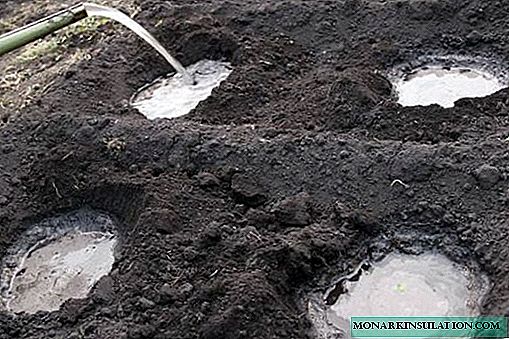
It is often convenient to fill the wells with mud, and plant seedlings in the mud
- Gently take the seedlings out of the box or cups, trying not to break the lump of earth, and plant it in the holes, deepening it down to the cotyledon leaves.
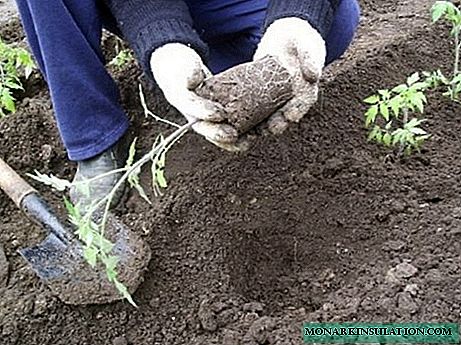
The less damaged the earthen lump, the faster the seedlings will take root
- Water the planted seedlings with water at a temperature of at least 25 aboutC and slightly mulch the soil around each plant.
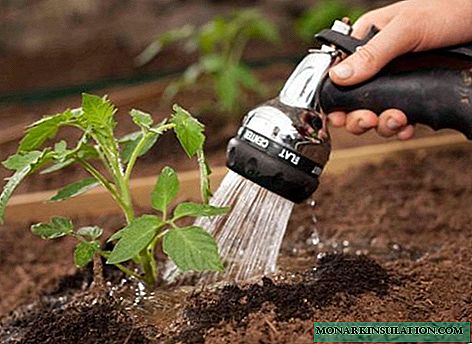
When watering, you must try not to fill the leaves, but the soil should be saturated with water qualitatively
It is best if seedlings are planted in cloudy weather or, in extreme cases, in the evening.
Care for tomato Yablonka of Russia
Caring for a tomato of this variety is extremely simple. It consists of watering, loosening the soil, the destruction of weeds and rare top dressing. Serious formation of bushes is not required: not everyone is involved in this planting, even it can not be tied up, although, of course, in case of abundant harvests it is better to help the bushes not to fall to the ground under the weight of the fruit.
Often, watering the Apple tree is not required: this is done only with a prolonged absence of rain. It is best to plan watering for the evening, when the water is warmed by the sun; watering with tap water from a hose is undesirable. So that the soil crust does not form, after irrigation it is necessary to slightly loosen the soil, if the bushes have not yet grown very much. When the tomatoes begin to stain, watered only in case of extreme drought, and then lightly.
It is highly desirable to feed tomatoes: without this, the yield will be significantly lower. But "for the busy" it will be enough to sprinkle around the bushes with wood ash about once every two weeks, at least from the consequences of barbecue weekend. But if there is time, it is worth watering the tomatoes every 2-3 weeks under the root with the infusion of mullein or, in its absence, with a weak solution of complex mineral fertilizer. Plants respond well to weeds.
The variety does not require the formation of bushes, but if there is time and desire, it is worth a little help to the plants. Of course, tying to pegs is desirable: after all, more than 50 fruits can form on each bush, and collecting them on the ground is not very aesthetically and conveniently. At first, you can do stepsoning, leaving 2-3 stems for subsequent growth. Subsequently, little stepsons are formed, and they can be ignored.
Video: on the formation of bushes of undersized tomatoes
In addition to late blight, this variety almost does not visit other diseases. Yes, and late blight - an infrequent guest. Therefore, prophylactic spraying with an infusion of onion peel is usually sufficient, except for extremely cold and wet seasons. If the sore still catches up, they try to use relatively harmless means like Fitosporin or Ridomil.
Harvesting in case of bad weather is better a little ahead of time: brown tomatoes ripen perfectly in room conditions. It is better to collect them unripe than to overload the bush. This is especially true of the last fruits, the ripening of which occurs at the end of summer and even the beginning of September.
Video: fruits after ripening in the room
Reviews
And the Yablonka of Russia has reached us. In our climate ... when many tomatoes are already in salads, it is just starting to pick up the color of the fruit, compared to other varieties planted at the same time. Indeed, there are many fruits and they are uniform. The bush is not sick. We plan to put it into the sunset. Like fruits and their shape and that uniform.
Olga Petrovna//www.tomat-pomidor.com/newforum/index.php?topic=2742.0
Planted the Apple tree of Russia. The tie is good in any weather, the bush is not very leafy. You need to stepchild constantly, but you can start up even three trunks. Carpal, but the tomatoes are not large. It tastes ordinary.I feel sorry for the place in the greenhouse under such a tomato, and it grows well in the exhaust gas. I planted it for three years in a row, but decided that I would not plant it again, a lot of varieties are more promising than Yablonki of Russia.
"Verina 4"//sitepokupok.ru/forum?page=165&thread=3749
This tomato was liked by its taste. Although the yield was not plentiful. The variety is a little moody, likes good watering. Fruits may fall due to lack of moisture. About a kilogram came out of the bush.
Irene//otzovik.com/review_5970229.html
I liked the apple of Russia grown by me in 2014, the fruits are smooth, the skin is slightly velvety, the taste is sweet-sour with a pronounced tomato smell, medium size, ideal for harvesting, my fruits in the jars cracked, maybe because I used very ripe fruits, next year I’ll try differently, I also read that you need to use a toothpick to prick a place at the tail, I’ll try, But still they are tasty both fresh and canned.
"feli_cita29"//feli-cita29.livejournal.com/9357.html
Tomato Yablonka of Russia is an example of tomatoes that are able to grow the most inexperienced summer resident in any region of our country. Its fruits cannot be considered ideal, but they are perfect for both summer salads and canning. The crop for the early ripening variety is quite good, and the quality of the tomatoes clearly exceeds the efforts that are spent on their production.




